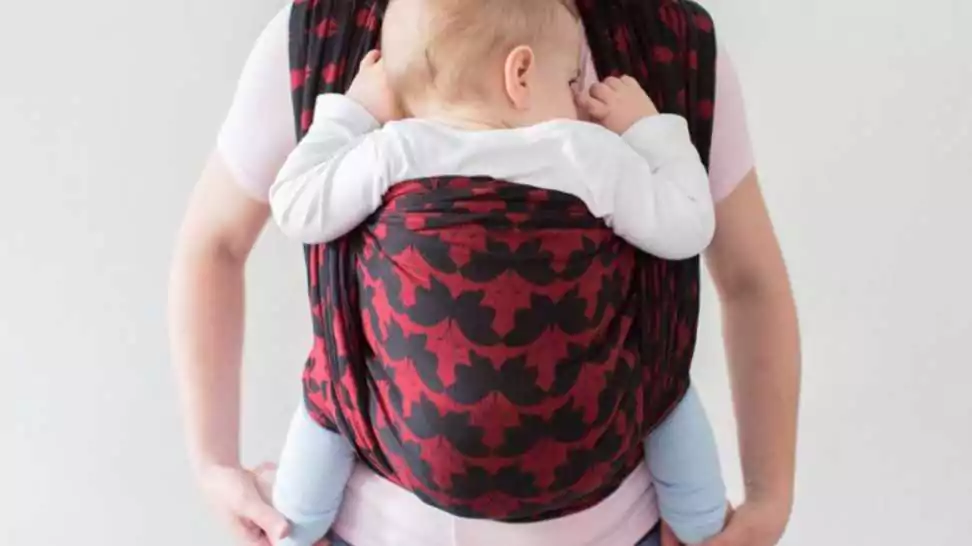Tips On How To Use Baby Carrier?

Baby wearing, an age-old tradition now revived with modern adaptations, beautifully connects generations, cultures, and families. More than a convenience, this practice nurtures a deep bond between parent and child while supporting the infant’s emotional, physical, and social development. Carrying a baby in a sling or carrier keeps them close, providing security and comfort through the parent’s touch and presence.
As parents navigate the wide array of baby carriers, a crucial question emerges: “when can we start using a baby carrier?” This guide delves into the timing and readiness, safety, and developmental considerations essential for both the child and the caregiver.
We will journey through the diverse world of how to use baby carrier, discussing types, uses, and selection criteria, and addressing the key question of when to begin baby-wearing. This comprehensive guide aims to empower you with knowledge and confidence, enriching the early years of parenting.
Embark on this exploration of baby wearing, a blend of tradition and modernity, to deepen the cherished connection with your child.
1 Understanding Baby Carriers
Embarking on the journey of baby wearing begins with understanding the different types of carriers available. Each type offers unique features and caters to various needs, preferences, and stages of your baby’s growth. Let’s explore these types in detail.

Types of Baby Carriers
1. Wrap: Wraps are long pieces of fabric that you can tie around your body in various ways to create a carrier. They are highly versatile and offer a custom fit every time. Perfect for newborns, they also adapt well as your baby grows.
2. Sling: Slings are typically a single piece of fabric that loops over one shoulder and forms a pouch to hold the baby. They are easy to use and great for quick trips. Ring slings, a variation, allow for adjustable tightness.
3. Mei-Tai: Mei-Tais blend the custom fit of wraps with the structured support of soft carriers. They have a panel with four straps that you tie around your body. They are excellent for babies who have begun to hold their heads up.
4. Soft Structured Carriers: These are the modern version of the baby carrier, offering padded straps and waistbands with adjustable buckles. Suitable for a range of ages, they are ideal for long-duration carrying.
5. Frame Carriers: Mostly used for older babies and toddlers, especially for outdoor activities like hiking. They have a framed structure for the baby to sit in and are carried like a backpack.
Pros and Cons of Each Type
1. Wrap
Pros: Highly adaptable, close contact, evenly distributes weight.
Cons: Learning curve to tie it correctly, can be time-consuming to set up.
2. Sling
Pros: Easy to use, compact, and good for breastfeeding.
Cons: Puts weight on one shoulder, not ideal for long use.
3. Mei-Tai
Pros: More structured than a wrap, easier to put on, good weight distribution.
Cons: May not offer as much support as structured carriers for heavier children.
4. Soft Structured Carriers
Pros: Ergonomic, adjustable, can be used for front and back carrying.
Cons: Can be bulky, not as snug as wraps or slings for newborns.
5. Frame Carriers
Pros: Great for outdoor activities, good for older children, sturdy.
Cons: Bulky, not suitable for infants, higher price point.
2 When to Start Using a Baby Carrier
Understanding the right time to start baby wearing is crucial for the safety and comfort of both the parent and the child. This section delves into the developmental stages of babies, paediatric guidelines, and the importance of tuning into your baby’s cues.
Understanding Baby’s Developmental Stages
- Importance of Neck and Head Support: One of the key factors in determining when to start using a baby carrier is the strength of your baby’s neck and head. Initially, babies lack the muscle strength to support their heads. As they grow, this strength develops, which is critical for safe baby wearing.
- Milestones for Carrier Readiness: Generally, babies are ready for a carrier when they have good head and neck control, which typically develops around 3-4 months of age. However, some carriers are designed for newborns with additional head support. It’s essential to choose a carrier that matches your baby’s current developmental stage.
Guidelines from Paediatricians
- Recommended Age and Weight to Start Using Carriers: Paediatricians often recommend waiting until a baby is around 4-6 months old before using a carrier that doesn’t offer specialized newborn support. The recommended weight varies depending on the carrier type but usually starts from around 7-10 pounds.
- Safety Considerations and Precautions: Ensure the baby’s face is always visible and not pressed against the fabric or the carrier’s body. Keep the chin off the chest to maintain an open airway. The carrier should also support the baby’s hips in a natural “M” position to promote healthy hip development.
Listening to Your Baby's Cues
- Recognizing Signs of Readiness: Beyond physical milestones, it’s important to observe your baby’s cues. Some babies might show a preference for being held close and are more content in a carrier, indicating readiness for baby wearing.
- Adjusting to Baby’s Comfort and Needs: Every baby is unique, and what works for one may not work for another. If your baby seems uncomfortable or fussy in the carrier, it might be necessary to try a different type or wait a bit longer before introducing baby wearing again.
3 How to Choose the Right Baby Carrier
Selecting the right baby carrier is a personal decision that depends on various factors including your baby’s development, your comfort, and your lifestyle. This section will guide you through the key considerations to make an informed choice.

Factors to Consider
- Baby’s Age and Weight: The age and weight of your baby are crucial in choosing a carrier. Newborns and smaller babies require carriers that offer more head and neck support, while older babies might need carriers that can accommodate their increased weight and allow for different carrying positions.
- Parent’s Comfort and Body Type: Not every carrier fits all body types comfortably. It’s important to choose a carrier that suits your body shape and size. Consider factors like back support, adjustable straps, and weight distribution to ensure it’s comfortable for you to wear for extended periods.
- Lifestyle and Usage Frequency: Your daily routine and how often you plan to use the carrier are also significant. If you’re an active parent who plans to use the carrier frequently, look for a durable and easy-to-use model. For occasional use, a simpler design might suffice.
Safety Features to Look For
- Secure Buckles and Straps: Check for strong, easy-to-use buckles and straps that can be adjusted securely and smoothly. This ensures your baby is safely fastened and the carrier stays comfortably in place.
- Adequate Head and Neck Support: Especially for newborns and young infants, ensure the carrier provides sufficient support for the baby’s head and neck. This is crucial to prevent any strain or injury.
- Breathable Materials: Comfort is key for both you and your baby. Look for carriers made from breathable materials to prevent overheating, especially in warmer climates or during extended use.
4 Step-by-Step Guide to Using a Baby Carrier
Mastering the use of a baby carrier can significantly enhance the baby wearing experience. This section provides a practical guide on preparing the carrier, positioning your baby correctly, and ensuring comfort and ease for both you and your child.
Preparing the Carrier
- Adjusting Straps and Settings for First-Time Use: Before using the carrier for the first time, familiarize yourself with its adjustments. Adjust the straps and settings according to your and your baby’s size. It’s often helpful to adjust the carrier with the help of another person to ensure a snug and comfortable fit.
- Safety Checks Before Each Use: Regularly inspect your carrier for any wear and tear, especially checking the buckles, straps, and fabric. Make sure all fastenings are secure and the fabric is not ripped or frayed, to ensure your baby’s safety during use.
Positioning Your Baby
- Demonstrating Various Carrying Positions: There are several carrying positions, such as front carry (facing in or out), back carry, and hip carry. Each position is suitable for different stages of your baby’s development. For instance, newborns should be carried in a front-facing position for better head and neck support.
- Ensuring Ergonomic Positioning for Baby’s Hip Health: It’s important to ensure that the baby is in an ergonomic position that supports healthy hip development. The ideal position is the ‘M’ position, where the baby’s knees are higher than their bottom, forming an M shape, which is natural and comfortable for the baby.
Tips for Comfort and Ease
- Adjusting for Parent’s Comfort: The carrier should be comfortable for the parent too. Adjust the straps so that the weight is evenly distributed across your shoulders and hips, minimizing strain on your back.
- Dressing Baby Appropriately for the Carrier: Dress your baby in comfortable, breathable clothes. Avoid bulky clothing that might make it hard to strap the baby securely or cause overheating. Also, consider the weather and layer appropriately.

5 Troubleshooting Common Issues
Even with the best preparation, you may encounter some challenges while baby wearing. Understanding how to address these issues can make your baby wearing journey smoother and more enjoyable.
Common Challenges and Solutions
- Baby Fussiness: It’s common for babies to be fussy when first introduced to a carrier. To soothe a fussy baby, ensure they’re not too hot or cold, the carrier isn’t too tight or loose, and they’re in a comfortable position. Sometimes, movement like walking or gentle rocking can help calm them.
- Discomfort for the Parent: If you experience discomfort, check that the carrier is adjusted correctly. The straps should be snug but not too tight, and the weight should be evenly distributed. Try different carrying positions to find the most comfortable one for you and your baby.
- Difficulty in Using Certain Types of Carriers: Some carriers have a steeper learning curve than others. If you’re struggling, seek advice from experienced baby wearers, watch instructional videos, or attend a baby wearing class. Practice makes perfect, so don’t be discouraged if it takes a few tries to get it right.
Maintenance and Care of Carriers
- Cleaning and Storage: Regular cleaning of your carrier is important for hygiene. Follow the manufacturer’s instructions for washing to avoid damaging the fabric or components. Store the carrier in a dry, cool place away from direct sunlight to prevent fading and deterioration.
- Regular Safety Checks: Regularly inspect your carrier for signs of wear and tear, especially if it’s used frequently or has been washed multiple times. Check for any loose threads, worn fabric, or damaged buckles and straps. If any part of the carrier is compromised, it’s safer to replace it.
6 Wrapping Up
This guide highlights the significance of understanding various baby carriers and selecting one that suits you and your baby’s growth. Emphasizing safe and comfortable baby wearing, it underscores the importance of safety, comfort, and convenience. Baby wearing is more than practical; it fosters an emotional bond and allows for closeness while staying active. Embrace baby wearing as a valuable part of parenthood, enhancing both the emotional connection and practicality of your parenting journey.
Community Q&A
About This Article
This article has been viewed 86 times.



